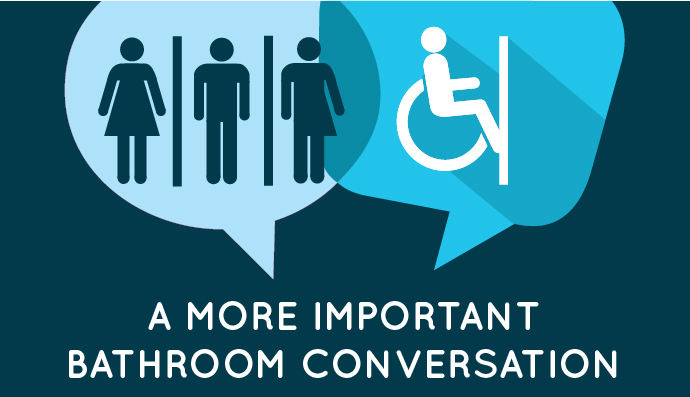A More Important Bathroom Conversation

Design for All, Universal Design
April 26, 2016
Combat Veteran’s Run for Office
May 10, 2016Recently, there has been a major discussion about public restrooms that has caused an all out riot on the internet and in the media. The “Bathroom Bill” requires that people over the age of 7 use the restroom that matches the sex on their birth certificates. While the law is aimed at transgender people, disability advocates worry that it also could affect people with disabilities who, because they need assistance from an opposite sex caregiver or parent, also use opposite sex bathrooms.
Parents of children with disabilities say that their children’s disabilities require that the parent and child stay together at all times. “They’re not very highfunctioning” said Jennifer Eldredge-Bird of Miami, whose sons, ages 11 and 15, have autism. Other parents agree that sending their disabled children into a public restroom alone is out of the question.
For Laura Rossi and her 13 yearold twins, using public bathrooms became more challenging as her children have gotten older. Her son, Matt, has Tourette syndrome, accompanied by a significant impairment of fine motor and social skills. When her twins were “little and cute” they were greeted by smiles and nodding heads, but as they got older, she began to see criticism when she took them into the women’s restroom. “Matt’s needs are invisible, and he got tall very quickly,” she said. “If there’s not a family bathroom, we got a lot of looks and comments, you know, meant for you to hear but not really ‘to’ you like ‘this is not the boys’ room.’”
With bathroom access a popular topic at the moment, many people with disabilities and their families are hoping that conversation extends to expanding access to public facilities for every person.
For many of the nearly one in five Americans with some disability, lack of access to public toilet facilities challenges their ability to take part in ordinary daily life and for some, the challenges are primarily physical.
Stalls that aren’t wide enough, doors that swing in instead of out, and various other things are part of a long list of things working against people who have disabilities that use public restrooms. Some have even had serious injuries due to insufficient space inside the stall to where they have fallen and hit their heads on poorly positioned toilet paper holders.
For other parents of teenage and adult children with physical disabilities, some of whom use diapers, or of older children and teenagers with autism or other cognitive and emotional difficulties the challenges have to do with their ability to assist family members.
Family members of people with disabilities say large, multistall public restrooms present the biggest challenge. Some large retailers now offer family bathrooms, which are ideal because they are private but large enough to accommodate multiple family members as well as wheelchairs and strollers. Individual bathrooms also work better for everyone, but space and cost constraints mean that many public spaces don’t offer them.
Eric Lipp, executive director of the Chicagobased Open Doors Organization, which advocates for people with disabilities in the travel and tourism industries, says there is a slowly growing movement to offer facilities for changing a diaper on an adult or an older child a large, stable surface, ideally with a life, like those designed by nonprofit Changingplaces.org.
Accessibility has unintended consequences that are good for everyone, and how we something as simple as a restroom can say a lot about how we think of people with disabilities in general.





